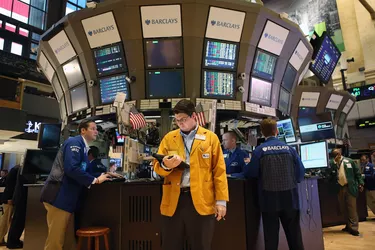
Dow Jones and Company is a giant in the United States publishing world, especially for financial information. Charles Dow, one of the founders of Dow Jones & Company, also founded the Wall Street Journal (WSJ), another giant in the world of financial news. Along with the WSJ, Charles Dow created the Dow Jones Industrial Average (DJIA).
When professionals or followers of the financial industry colloquially refer to the "Dow," they probably are referring to the DJIA (although there are a number of other Dow indices as well, including the Dow Jones Total Stock Market Index and The Global Dow). When the news anchor reports that the Dow is down for the day, she is referring to the DJIA.
Video of the Day
Video of the Day
Step 1
Understand what stocks comprise the DJIA. The DJIA includes U.S.-listed stocks of 30 of the largest and best-known companies providing non-transportation and non-utility goods and services. Because the goal of the DJIA is to measure the performance of the U.S. economy as a whole, this definition of "industrial" is intentionally broad. The editors of the WSJ maintain the list of these stocks, so the process is somewhat subjective.
Step 2
Obtain a DJIA quote. Numerous financial websites offer stock and index quotes, with both real-time and delayed quotes. Different companies use different symbols to represent the index: "^DJI" (Yahoo! Finance); "DJIND" (E*Trade Financial); "DJIA" (TD Ameritrade); "DOW" (money.cnn.com). Again, because the DJIA is an index and not a security, the companies can use different "symbols" to track the index in their individual systems.
Step 3
Learn how to read an index quote. Quotes generally show the price (a cumulative price of the last trades for each of the 30 companies underlying the index); the opening/high/low/previous close price; the year-to-date (YTD) percentage change in the price; volume (total number of shares traded for the 30 companies that day); and the 52-week price range (high and low).
Step 4
Compare the individual stocks underlying the index. The 30 companies that make up the DJIA are some of the largest companies in the country. But that does not mean that they are immune to forces that affect smaller companies. GM was a component of the DJIA from 1925 until the automaker went bankrupt in 2009. Citigroup, which also was replaced in 2009, had been a component company since 1997.
Step 5
Compare the DJIA with other indices. Standard and Poor's (S&P) 500, Russell Investment Group's Russell 2000, and the Wilshire 5000 index are other popular stock market indices. The DJIA tracks 30 stocks, whereas the Wilshire 5000, as the name implies, tracks 5000 stocks and as such is considered a Total Stock Market Index. Dow Jones also offers a number of other indices, such as international and technology indices. No one index provides the whole picture of the market, so be sure to review other indices as well.
Tip
Some beginning investors think they can just buy shares in the index itself, but that is not the case. The index tracks stocks; it is not itself an investment. Instead, an investor can either purchase shares for each of the 30 companies underlying the index, or look for mutual funds or exchange traded funds (ETFs) that track the index.